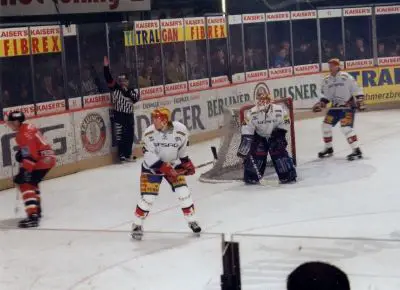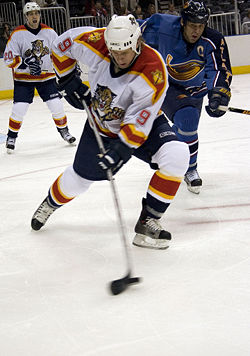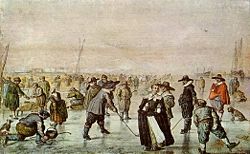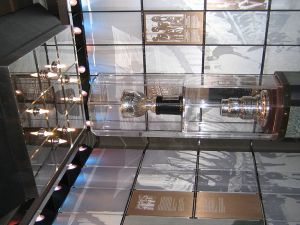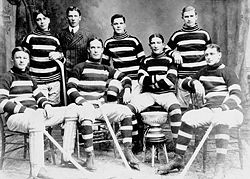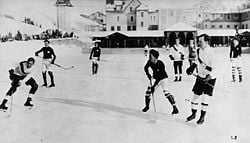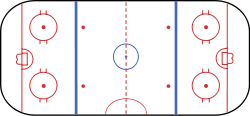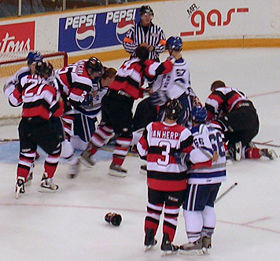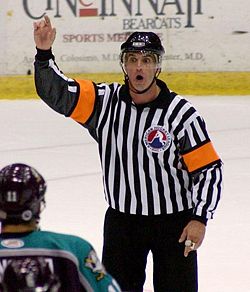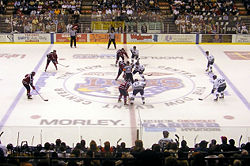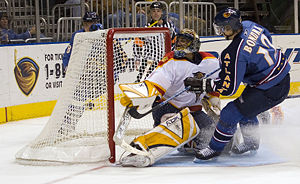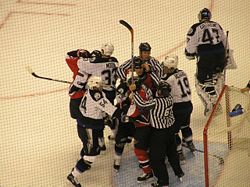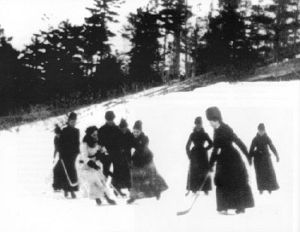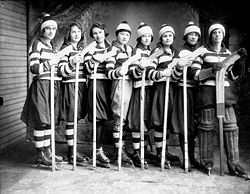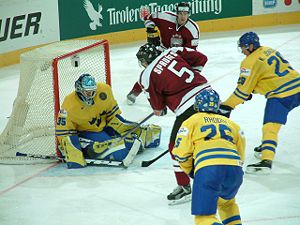Ice hockey
Ice hockey one of the more physical sports, is one of the four major professional sports, and is represented by the National Hockey League (NHL) at its highest level. The sport itself is played on numerous levels, including men and women's NCAA hockey, men and women's national hockey league, etc. What arose as a pastime in Canada has become popular in almost all parts of the world, especially the colder areas, where hockey can be played outdoors on ice. In fact, Canadian hockey comprises of six teams of the NHL, and the number of Canadian players in comparison to Americans is approximately four to one.
The sport's popularity in the U.S. is concentrated in certain regions, notably the Northeast, the Midwest, and Alaska. This concentration helps to make ice hockey the least watched major sport in the United States, though it is by far the most watched sport in Canada. Nonetheless, in certain major U.S. cities like Buffalo, Detroit, Pittsburgh, Minnesota, Chicago, Boston, New York, Philadelphia, Tampa Bay, Denver, San Jose, and Columbus it commands popularity levels similar to and occasionally exceeding basketball for winter sports fans.
While there are 72 total members of the International Ice Hockey Federation (IIHF), Canada, the Czech Republic, Finland, Russia, Slovakia, Sweden, and the United States have finished in most of the coveted first, second, and third places at IIHF World Championships. Those seven nations have also captured 162 of 177 medals awarded at 59 non-Olympic IIHF World Championships, and all medals since 1954. Likewise, all nine Olympic and 27 IIHF World Women Championships medals have gone to one of those seven countries. Also deserving an honorable mention is Switzerland, which has won two men's bronze medals at the Olympics and finished at least third seven times at the World Championships. Switzerland also maintains one of the oldest and top-rated ice hockey leagues (the Swiss Nationalliga) outside of the NHL.
History
Games between teams hitting an object with curved sticks have been played throughout history; 4000 year-old drawings at the Beni-Hasen tombs in Egypt depict a sport resembling field hockey.[1] The 1527 Galway Statutes in Ireland made reference to "the horlinge of the litill balle with hockie stickes or staves."[2] The etymology of the word hockey is uncertain. It may derive from the Old French word hoquet, shepherd's crook, or from the Middle Dutch word hokkie, meaning shack or doghouse, which in popular use meant goal. Many of these games were developed for fields, though where conditions allowed they were also played on ice. Seventeenth-century Dutch paintings show townsfolk playing a hockey-like game on a frozen canal.
European immigrants brought various versions of hockey-like games to North America, such as the Scottish sport of shinty, the closely-related Irish sport of hurling, and versions of field hockey played in England. Where necessary these seem to have been adapted for icy conditions; for example, a colonial Williamsburg newspaper records hockey being played in a snow storm in Virginia. Both English- and French-speaking Canadians played hockey on frozen rivers, lakes, and ponds using cheese cutters strapped to their boots, and early paintings show "shinney," an early form of hockey with no standard rules, being played in Nova Scotia. Author Thomas Chandler Haliburton included in a work of fiction a story about boys from King's College School in Windsor, Nova Scotia, playing "hurley on the ice" when he was a student there around 1800 (Ed. Note: Haliburton was born in 1796).[3] To this day, "Shinny" (derived from Shinty) is a popular Canadian term for an informal type of hockey, either on ice or as street hockey. These early games may have also absorbed the physically aggressive aspects of what the Mi'kmaq Aboriginal First Nation in Nova Scotia called dehuntshigwa'es (lacrosse).
In 1825 Sir John Franklin wrote that "The game of hockey played on the ice was the morning sport" while on Great Bear Lake during one of his Arctic expeditions. In 1843 a British Army officer in Kingston, Ontario, wrote "Began to skate this year, improved quickly and had great fun at hockey on the ice."[4] A Boston Evening Gazette article from 1859 makes reference to an early game of hockey on ice occurring in Halifax in that year. The first game to use a "puck-like" object rather than a ball took place in 1860 on Kingston Harbour, involving mostly Crimean War veterans [5]
Based on Haliburton's writings, there have been claims that modern ice hockey originated in Windsor, Nova Scotia, and was named after an individual, as in 'Colonel Hockey's game'.[6] Proponents of this theory claim that the surname Hockey exists in the district surrounding Windsor. In 1943, the Canadian Amateur Hockey Association declared Kingston the birthplace of hockey, based on a recorded 1886 game played between students of Queen's University and the Royal Military College of Canada.
The Society for International Hockey Research has had an "origins of hockey" committee studying this debate since 2001 and they defined hockey as "a game played on an ice rink in which two opposing teams of skaters, using curved sticks, try to drive a small disc, ball or block into or through the opposite goals."
The committee found evidence of stick and ball games played on ice on skates in Europe in the sixteenth through eighteenth centuries, and viewed these activities as being more indicative of a hockey-like game than Haliburtonâs reference.
They found no evidence in the Windsor position of a connection from whatever form of hockey might have been played at Long Pond to the game played elsewhere and to modern hockey. The committee viewed as conjecture the assertion that Kingâs schoolboys introduced the game to Halifax. They noted that the assertion that hockey was not played outside Nova Scotia until 1865 overlooks diary evidence of shinny and hockey being played at Kingston in the 1840s.
The committee concluded that Dr. Vaughan and the Windsor Hockey Heritage Society had not offered credible evidence that Windsor, Nova Scotia, is the birthplace of hockey.
The committee offered no opinion on the birth date or birthplace of hockey, but took note of a game at Montrealâs Victoria Skating Rink on March 3, 1875. This is the earliest eyewitness account known to the committee of a specific game of hockey in a specific place at a specific time, and with a recorded score, between two identified teams.
The word hockey is believed to have several derivations, the most common one being from an old French word "hoquet," which means curved stick, or more specifically "shepherd s crook." In Germanic languages, there is a very old root word "hok" or "hak," which means a bent or curved piece of wood or metal.
According to the Society for International Hockey Research, the word puck is derived from the Scottish and Gaelic word "puc" or the Irish word "poc," meaning to poke, punch or deliver a blow. This definition is explained in a book published in 1910 entitled "English as we Speak it in Ireland" by P.W. Joyce. It defines the word puck as "⌠The blow given by a hurler to the ball with his caman or hurley is always called a puck."
Foundation of the modern game
The foundation of the modern game centered on Montreal, Quebec. On March 3, 1875, the first organized indoor game was played at Montreal's Victoria Rink by James Creighton and several McGill University students. In 1877, several McGill students, including Creighton, Henry Joseph, Richard F. Smith, W. F. Robertson, and W. L. Murray codified seven ice hockey rules. The first ice hockey club, McGill University Hockey Club, was founded in 1877.[7]
The game became so popular that the first "world championship" of ice hockey was featured in Montreal's annual Winter Carnival in 1883 and the McGill team captured the "Carnival Cup." In 1885, A. P. Low introduced the game to Ottawa. Although undocumented, it is believed that during the same year, the Oxford University Ice Hockey Club was formed to play the first Ice Hockey Varsity Match against traditional rival Cambridge in St. Moritz, Switzerland. This match was won by the Oxford Dark Blues, 6-0.[8][9] The first photographs and team lists date from 1895.[10] This continues to be the oldest hockey rivalry in history.
In 1888, the new Governor General of Canada, Lord Stanley of Preston, whose sons and daughter became hockey enthusiasts, attended the Montreal Winter Carnival tournament and was impressed with the hockey spectacle. In 1892, recognizing that there was no recognition for the best team, Lord Stanley purchased a decorative bowl for use as a trophy. The Dominion Hockey Challenge Cup, which later became more famously known as the Stanley Cup, was first awarded in 1893 to the champion amateur team in Canada, Montreal AAA. It continues to be awarded today to the National Hockey League's championship team.[11]
By 1893, there were almost a hundred teams in Montreal alone, and leagues throughout Canada. Winnipeg hockey players had incorporated cricket pads to better protect the goaltender's legs. They also introduced the "scoop" shot, later known as the wrist shot.
1893 also saw the first ice hockey matches in the U.S., at Yale University and Johns Hopkins University.[12] The U.S. Amateur Hockey League was founded in New York City in 1896, and the first professional team, the Portage Lakers was formed in 1903 in Houghton, Michigan (although there had been individual professionals in Canada before this).
The five sons of Lord Stanley were instrumental in bringing ice hockey to Europe, beating a court team (which included both the future Edward VII and George V) at Buckingham Palace in 1895. By 1903 a five-team league had been founded. The Ligue Internationale de Hockey sur Glace was founded in 1908 to govern international competitions, and the first European championships were won by Great Britain in 1910. In the mid-20th century, the Ligue became the International Ice Hockey Federation.[13]
The professional era
Professional ice hockey has existed since after World War I. From the first professional ice hockey league based out of Michigan in the United States, it quickly grew into Canada and in many other countries, including Switzerland, Ukraine, Great Britain and Austria.
Equipment
Ice hockey tends to be a dangerous sport. Protective equipment is highly recommended and is enforced in all competitive situations. This usually includes a helmet, shoulder pads, elbow pads, mouth guard, protective gloves, heavily padded shorts, a 'jock' athletic protector, shin pads/chest protector and a neck guard.
Game
While the general characteristics of the game are the same wherever it is played, the exact rules depend on the particular code of play being used. The two most important codes are those of the International Ice Hockey Federation (IIHF)[14] and of the North American National Hockey League (NHL).[15] North American amateur hockey codes, such as those of Hockey Canada and USA Hockey, tend to be a hybrid of the NHL and IIHF codes, while professional rules generally follow those of the NHL.
Ice hockey is played on a hockey rink. During normal play, there are six players per side on the ice at any time, each of whom is on ice skates. There are five players and one goaltender per side. The objective of the game is to score goals by shooting a hard vulcanized rubber disc, the puck, into the opponent's goal net, which is placed at the opposite end of the rink. The players may control the puck using a long stick with a blade that is commonly curved at one end. Players may also redirect the puck with any part of their bodies, subject to certain restrictions. Players can angle their feet so the puck can redirect into the net, but there can be no kicking motion. Players may not intentionally bat the puck into the net with their hands or with a high stick (above the shoulder).
Hockey is an "offside" game, meaning that forward passes are allowed, unlike in rugby. Before the 1930s hockey was an onside game, meaning that only backward passes were allowed. The period of the onside game was the golden age of stick-handling, which was of prime importance in moving the game forward. With the arrival of offside rules, the forward pass transformed hockey into a truly team sport, where individual heroics diminished in importance relative to team play, which could now be coordinated over the entire surface of the ice as opposed to merely rearward players.[16]
The other five players are typically divided into three forwards and two defensemen. The forward positions consist of a center and two wingers: a left wing and a right wing. Forwards often play together as units or lines, with the same three forwards generally playing together. The defensemen usually stay together as a pair, but may change less frequently than the forwards. A substitution of an entire unit at once is called a line change. Teams typically employ alternate sets of forward lines and defensive pairings when shorthanded or on a power play. Substitutions are permitted at any time during the course of the game, although during a stoppage of play the home team is permitted the final change. When players are substituted during play, it is called changing on the fly. A new NHL rule added in the 2005-2006 season prevents a team from changing their line after they ice the puck.
The boards surrounding the ice help keep the puck in play (they can also be used as tools to play the puck), and play often proceeds for minutes without interruption. When play is stopped, it is restarted with a faceoff. There are two major rules of play in ice hockey that limit the movement of the puck: offsides and icing.
Under IIHF rules, each team may carry a maximum of 20 players and two goaltenders on their roster. NHL rules restrict the total number of players per game to 18 plus two goaltenders.
Penalties
For most penalties, the offending player is sent to the penalty box and his team has to play without him and with one less skater for a period of time. Most penalties last for two minutes unless a major penalty has been assessed. This gives the other team what is popularly termed a power play.
A two-minute minor penalty is often called for lesser infractions such as tripping, elbowing, roughing, high-sticking, too many players on the ice, illegal equipment, charging (leaping into an opponent or body-checking him after taking more than two strides), holding, interference, delay of game, hooking, or cross-checking. In the 2005-06 NHL season, a minor is also assessed for diving, where a player embellishes a hook or trip. More egregious fouls of this type may be penalized by a four-minute double-minor penalty, particularly those which (inadvertently) cause injury to the victimized player. These penalties end either when the time runs out or the other team scores on the power play. In the case of a goal scored during the first two minutes of a double-minor, the penalty clock is set down to two minutes upon a score (effectively expiring the first minor). Five-minute major penalties are called for especially violent instances of most minor infractions that result in intentional injury to an opponent, as well as for fighting. Major penalties are always served in full; they do not terminate on a goal scored by the other team. The foul of 'boarding', defined as "check[ing] an opponent in such a manner that causes the opponent to be thrown violently in the boards" by the NHL Rulebook is penalized either by a minor or major penalty at the discretion of the referee, based on the violence of the hit. A minor or major penalty for "Boarding" is also often assessed when a player checks an opponent from behind and into the boards.
Some varieties of penalties do not always require the offending team to play a man short. Five-minute major penalties in the NHL usually result from fighting. In the case of two players being assessed five-minute fighting majors, they both serve five minutes without their team incurring a loss of player (both teams still have a full complement of players on the ice). This differs with two players from opposing sides getting minor penalties, at the same time or at any intersecting moment, resulting from more common infractions. In that case, both teams will have only four skating players (not counting the goaltender) until one or both penalties expire (if one expires before the other, the opposing team gets a power play for the remainder); this applies regardless of current pending penalties, though in the NHL, a team always has at least three skaters on the ice. Ten-minute misconduct penalties are served in full by the penalized player, but his team may immediately substitute another player on the ice unless a minor or major penalty is assessed in conjunction with the misconduct (a two-and-ten or five-and-ten). In that case, the team designates another player to serve the minor or major; both players go to the penalty box, but only the designee may not be replaced, and he is released upon the expiration of the two or five minutes, at which point the ten-minute misconduct begins. In addition, game misconducts are assessed for deliberate intent to inflict severe injury on an opponent (at the officials' discretion), or for a major penalty for a stick infraction or repeated major penalties. The offending player is ejected from the game and must immediately leave the playing surface (he does not sit in the penalty box); meanwhile, if a minor or major is assessed in addition, a designated player must serve out that segment of the penalty in the box (similar to the above-mentioned "two-and-ten").
A player who is tripped, or illegally obstructed in some way, by an opponent on a breakawayâwhen there are no defenders except the goaltender between him and the opponent's goalâis awarded a penalty shot, an attempt to score without opposition from any defenders except the goaltender. A penalty shot is also awarded for a defender other than the goaltender covering the puck in the goal crease, a goaltender intentionally displacing his own goal posts during a breakaway in order to avoid a goal, a defender intentionally displacing his own goal posts when there is less than two minutes to play in regulation time or at any point during overtime (goalposts are not anchored to prevent serious injury), or a player or coach intentionally throwing a stick or other object at the puck or the puck carrier and the throwing action disrupts a shot or pass play.
Officials also stop play for puck movement violations, such as using one's hands to pass the puck in the offensive end, but no players are penalized for these offenses. The sole exceptions are deliberately falling on or gathering the puck to the body, carrying the puck in the hand, and shooting the puck out of play in one's defensive zone (all penalized two minutes for delay of game). In the NHL, there is an area behind the goal line that goaltenders are not allowed to play the puck. Doing so also results in a delay of game minor.
A new penalty in the NHL applies to the goalies. The goalies now are unable to play the puck in the "corners" of the rink near their own net. This will result in a two-minute penalty against the goalie's team. (Goalies do not serve penalties; someone from their team is designated to serve the penalty for them.) The area immediately behind the net is the only area behind the net in which the goalie can play the puck.
An additional rule that is not a penalty in the new NHL is the two line offside passes. There are no more two-line offside pass whistles blown. Now players are able to pass to teammates who are more than the blue and center ice red line away.
The NHL has taken steps to speed the game of hockey up and create a game of finesse, which is different from the past where hockey was a game of hits, fights, and penalties. Today's game of hockey is a stricter called game which in-turn provides more protection to the players and allows for more goals to be scored.
There are many infractions for which a player may be assessed a penalty. The governing body for United States amateur hockey has implemented many new rules to reduce the number stick-on-body occurrences, as well as other detrimental and illegal facets of the game ("Zero Tolerance").
In men's hockey, but not in women's, a player may use his hip or shoulder to hit another player if the player has the puck or is the last to have touched it. (In the NHL, you can hit an opposing player only for a brief moment after he loses control of the puckâusually less than 3 secondsâwithout incurring a penalty.) This use of the hip and shoulder is called body checking. Not all physical contact is legal; in particular, hits from behind and most types of forceful stick-on-body contact are illegal.
Officials
A typical game of ice hockey has two to four officials on the ice, charged with enforcing the rules of the game. There are typically two linesmen who are responsible only for calling offside and icing violations, and one or two referees, who call goals and all other penalties. Linesmen can, however, report to the referee(s) that a penalty more severe than a two-minute minor penalty should be assessed against an offending player. On-ice officials are assisted by off-ice officials who act as goal judges, time keepers, and official scorers.
Officials are selected by the league for which they work. Amateur hockey leagues use guidelines established by national organizing bodies as a basis for choosing their officiating staffs. In North America, the national organizing bodies Hockey Canada and USA Hockey approve officials according to their experience level as well as their ability to pass rules knowledge and skating ability tests. Hockey Canada has officiating levels I through VI. USA Hockey has officiating levels 1 through 4.
Tactics
An important defensive tactic is checkingâattempting to take the puck from an opponent or to remove the opponent from play. Forechecking is checking in the other team's zone; backchecking is checking while the other team is advancing down the ice toward one's own goal. These terms usually are applied to checking by forwards. Stick checking, sweep checking, and poke checking are legal uses of the stick to obtain possession of the puck. Body checking is using one's shoulder or hip to strike an opponent who has the puck or who is the last to have touched it (within a short period of time after possession; usually less than three seconds). Often the term checking is used to refer to body checking, with its true definition generally only propagated among fans of the game.
Offensive tactics include improving a team's position on the ice by advancing the puck out of one's zone towards the opponent's zone, progressively by gaining lines, first your own blue line, then the red line and finally the opponent's blue line. Offensive tactics are designed ultimately to score a goal by taking a shot. When a player purposely directs the puck towards the opponent's goal, he or she is said to shoot the puck.
A deflection is a shot which redirects a shot or a pass towards the goal from another player, by allowing the puck to strike the stick and carom towards the goal. A one-timer is a shot which is struck directly off a pass, without receiving the pass and shooting in two separate actions. A deke (short for decoy) is a feint with the body and/or stick to fool a defender or the goalie. Headmanning the puck is the tactic of rapidly passing to the player farthest down the ice.
A team that is losing by one or two goals in the last few minutes of play may elect to pull the goalie; that is, removing the goaltender and replacing him or her with an extra attacker on the ice in the hope of gaining enough advantage to score a goal. However, this tactic is extremely risky, and sometimes leads to the opposing team extending their lead by scoring a goal in the empty net.
Although it is officially prohibited in the rules, at the professional level in North America fights are sometimes used to affect morale of the teams, with aggressors hoping to demoralize the opposing players while exciting their own, as well as settling personal scores. Both players in an altercation receive five-minute major penalties for fighting. The player deemed to be the "instigator" of an NHL fight, if one is determined to exist, is penalized an additional two minutes for instigating, plus a ten-minute misconduct penalty. If there is no instigator, both players stay in the penalty box for five minutes, and neither team lose skaters. This so-called instigator rule is highly controversial in NHL hockey: many coaches, sportswriters, players and fans feel it prevents players from effectively policing the objectionable behavior of their peers, which is often cleverly hidden from referees. They point to less extreme on-ice violence during the era before the rule was introduced. Toronto Maple Leafs owner Conn Smythe famously observed that "If you can't beat 'em in the alley you can't beat 'em on the ice."[17]
The Neutral zone trap:
The trap is designed to isolate the puck carrier in the neutral zone preventing him from entering the offensive zone. In youth hockey development of the neutral zone trap often begins with the left wing lock. In this tactic the left wing plays in the normal position of the left defense men while in the offensive zone. The left defenseman then moves to the center. The center and right wing chase the puck. When the opposing team gains control of the puck, the defensemen and the left wing pull out and set a two man trap along the boards. The left or right wing available, backs up the trap while the center and right wing pursuit and try to get in front of the play further blocking the offensive attack.
Periods and overtime
A game consists of three periods of twenty minutes each, the clock running only when the puck is in play. The teams change ends for the second period, again for the third period, and again at the start of each overtime played. Recreational leagues and children's leagues often play shorter games, generally with three shorter periods of play.
Various procedures are used if a game is tied. In tournament play, as well as in the NHL playoffs, North Americans favor sudden death overtime, in which the teams continue to play 20 minute periods until a goal is scored. Up until the 1999-2000 season regular season NHL games were settled with a single 5 minute sudden death period with 5 players (plus a goalie) per side, with the winner awarded 2 points in the standings and the loser 0 points. In the event of a tie (if the OT was scoreless), each team was awarded 1 point. From 1999-2000 until 2003-04 the National Hockey League decided ties by playing a single five-minute sudden death overtime period with each team having 4 players (plus a goalie) per side to "open-up" the game. In the event of a tie, each team would still receive 1 point in the standings but in the event of a victory the winning team would be awarded 2 points in the standings and the losing team 1 point. The only exception to this rule is if a team opts to pull their goalie in exchange for an extra skater during overtime and is subsequently scored upon (an 'Empty Net' goal), in which case the losing team receives no points for the overtime loss. International play and several North American professional leagues, including the NHL (in the regular season), now use an overtime period followed by a penalty shootout. If the score remains tied after an extra overtime period, the subsequent shootout consists of three players from each team taking penalty shots. After these six total shots, the team with the most goals is awarded the victory. If the score is still tied, the shootout then proceeds to a sudden death (actually sudden victory) format. Regardless of the number of goals scored during the shootout by either team, the final score recorded will award the winning team one more goal than the score at the end of regulation time. In the NHL if a game is decided by a shootout the winning team is awarded 2 points in the standings and the losing team is awarded 1. Ties no longer occur in the NHL. Also, no statistics in the shootout count-no goals are awarded to players who score in the shootout, and goalkeepers are not credited with saves or goals against. Therefore, it is possible for a goalie to lose a game in which he gets a shutout.
Women's ice hockey
History of women's ice hockey
Lord Stanley of Preston's daughter, Lady Isobel Stanley, was a pioneer in the women's game and is one of the first females to be photographed using puck and stick (around 1890) on the natural ice rink at Rideau Hall in Ottawa. By the early 1900s, women's teams were common throughout most of the Canadian provinces, the long skirts they were still required to wear giving them a goal-tending advantage. On February 11, 1891, one of the earliest newspaper accounts of a game between women appeared in the Ottawa Citizen, and McGill University's women's hockey team debuted in 1894.[18]
Women's ice hockey today
Ice hockey is one of the fastest growing women's sports in the world, with the number of participants increasing 400 percent in the last ten years.[19] While there are not as many organized leagues for women as there are for men, there exist leagues of all levels, including the National Women's Hockey League, Western Women's Hockey League, and various European leagues; as well as university teams, national and Olympic teams, and recreational teams. There have been nine IIHF World Women Championships.[20]
Women's ice hockey was added as a medal sport at the 1998 Winter Olympics in Nagano, Japan. The United States won gold, Canada won silver and Finland won bronze.[21]
The chief difference between women's and men's ice hockey is that bodychecking is not allowed in women's ice hockey. After the 1990 Women's World Championship, bodychecking was eliminated because female players in many countries do not have the size and mass seen in North American players. There are many who feel that the relative lack of physical play is a detriment to its popularity among the mainstream hockey public, while others feel its absence leads to a faster game more reliant on skating and puck-handling skills. In current IIHF women's competition, bodychecking is either a minor or major penalty, decided at the referee's discretion.[22]
In addition, players in women's competition are required to wear protective full-face masks.[22]
One woman, Manon RhĂŠaume, appeared as a goaltender for the Tampa Bay Lightning in preseason games against the St. Louis Blues and the Boston Bruins, and in 2003 Hayley Wickenheiser played with the Kirkkonummi Salamat in the Finnish men's Suomi-sarja league. Several women have competed in North American minor leagues, including goaltenders Charline LabontĂŠ, Kelly Dyer, Erin Whitten, Manon RhĂŠaume, and defenceman Angela Ruggiero.
Sledge hockey
Sledge hockey is a form of ice hockey designed for players with physical disabilities affecting their lower bodies. Players sit on double-bladed sledges and use two sticks; each stick has a blade at one end and small picks at the other. Players use the sticks to pass, stickhandle and shoot the puck, and to propel their sledges. The rules are very similar to IIHF ice hockey rules.[23]
Canada is a recognized international leader in the development of the sport, and of equipment for players. Much of the equipment for the sport was first developed in Canada, such as sledge hockey sticks laminated with fiberglass, as well as aluminum shafts with hand carved insert blades and special aluminum sledges with regulation skate blades.
The sport of hockey, like in many other sports, has fallen prey to a myriad of mergers, and leagues folding and expanding routinely.
International competition and Hockey Leagues
The annual men's Ice Hockey World Championships are highly regarded by Europeans, but they are less important to North Americans because they coincide with the Stanley Cup playoffs. Consequently, Canada, the United States, and other countries with large numbers of NHL players have not always been able to field their best possible teams because many of their top players are playing for the Stanley Cup. Furthermore, for many years professionals were barred from play. Now that many Europeans play in the NHL, the world championships no longer represent all of the world's top players.
Hockey has been played at the Winter Olympics since 1924 (and at the summer games in 1920). Canada won six of the first seven gold medals. The United States won their first gold medal in 1960. The USSR won all but two Olympic ice hockey gold medals from 1956 to 1988 and won a final time as the Unified Team at the 1992 Albertville Olympics. Since all players in the communist system were "amateurs," the USSR's elite national team was the best the country had to offer, while the best Americans, Swedes, Finns, and Canadians were professionals and thus barred from Olympic competition. Nonetheless, U.S. amateur college players defeated the heavily favored Soviet squad on the way to winning the gold medal at the 1980 Lake Placid Olympics. This "Miracle on Ice" launched a surge of newfound popularity for a game about which many Americans had not cared much.
The 1972 Summit Series and 1974 Summit Series, established Canada and the USSR as a major international ice hockey rivalry. It was followed by five Canada Cup tournaments, where the best players from every hockey nation could play, and two exhibition series, the 1979 Challenge Cup and Rendez-vous '87 where the best players from the NHL played the USSR. The Canada Cup tournament later became the World Cup of Hockey, played in 1996 and 2004. The United States won in 1996 and Canada won in 2004. Since 1998, NHL professionals have played in the Olympics, giving the best players in the world more opportunities to face off.
There have been nine women's world championships, beginning in 1990.[20] Women's hockey has been played at the Olympics since 1998.[21] The 2006 Winter Olympic final between Canada and Sweden marked the first women's world championship or Olympic final that did not involve both Canada and the United States.
National Hockey League (NHL)
The NHL is the most prestigious, top-tier league in hockey. Until 1904, hockey was strictly played as a leisure sport, as professional hockey leagues loomed beyond the horizon. The International Pro Hockey League changed that, but did not leave any lasting impact, collapsing a mere three years later (1907). However, the IPHL paved the way for the National Hockey Association in 1910. The Pacific Coast League followed, and set up a competitive series between the two leagues. The winner claimed his right to the coveted cup of Lord Stanley (future inference to the Stanley Cup). World War I threw the entire hockey establishment into disarray, and the men running the NHA decided to suspend operations. Following the war, the Montreal Amateur Athletic Association formed the National Hockey League, starting with only five teams: the Montreal Canadiens, the Montreal Wanderers, the Ottawa Senators, the Quebec Bulldogs, and the Toronto Arenas. The league's first game was held Dec. 19, 1917. The clubs played a 22-game schedule and, picking up on a rule change instituted by the old NHA, dropped the rover and employed only six players on a side. Toronto finished that first season on top, and in March 1918 met the Pacific Coast League champion Vancouver Millionaires for the Stanley Cup. Toronto won, three games to two. Eventually the PCL folded, and at the start of the 1926 season, the NHL, which at that point had ten teams, divided into two divisions and took control of the Stanley Cup.
International Hockey League (IHL)
- 1904-1907
The International Hockey League has appeared in numerous forms throughout history, the most recent being the one created in 2007. However, the IHL first was created in 1904 by Jack 'Doc' Gibson, a dentist who played hockey throughout Ontario before settling in Houghton, Michigan. The IPHL was a five team circuit which included Pittsburgh, Pennsylvania, Sault Ste. Marie, Ontario, Sault Ste. Marie, Michigan, Calumet, Michigan and Houghton. At that time, the duration of the hockey season was only two months because the teams played on natural ice. As a result of these natural circumstances, the hockey league failed to muster up anything consistent until later.
- 1929-1936
The IHL was resurrected for a period of seven years and flourished until it merged with the Canadian Hockey League, and became known as the International American Hockey League.
- 1945-2001
The IHL was formed in December 1945 and initially consisted of four cross-border teams in Detroit and Windsor, Ontario. In 1947, a team from Toledo, Ohio joined the league, and the following year the IHL expanded significantly, with teams in four additional U.S. cities. Starting in the late 1960s, the IHL's quality of play significantly upgraded until by the mid-1970s, it was on par with the American Hockey League (AHL), the longtime top feeder league for the National Hockey League. The IHL and the NHL were on competitive levels towards the middle of the 1990s, when the NHL experienced a lock-out shortened season. However, in 2001, the IHL collapsed, and six of its teams in the league became expansion teams with the American Hockey League.
- 2007-
The International Hockey League (IHL) is a professional ice hockey league with teams in the United States. The league is headquartered in Rochester, Michigan and stemmed from a minor-league association named the Colonial Hockey League.
International Ice Hockey Federation (IIHF)
The International Ice Hockey Federation was created in 1908 as a means of forming a foundation and unification of hockey players all over the world. When hockey first became relevant as a sport in 1875, a set of rules were created, and the modern day NHL and international hockey rules have evolved from that.
1. A face-off in the center shall start the game in the beginning and after a goal. For this purpose, the puck (ball) shall be placed between two players.
2. Once a player touched (hit) the ball (puck), anybody who was near the opponentâs goal line at the time the puck was touched shall not be allowed to take part in the game. Players must always be on the same side as the puck.
3. The puck (ball) may be stopped but must not be carried. Players are not allowed to carry their sticks above the height of their shoulders. Attacking from behind, holding the collar, treading or kicking is forbidden.
It all began with a congregation of the "Ligue Internationale de Hockey sur Glace" (LIHG). This congregation included France, Bohemia, Great Britain, Switzerland, and Belgium. In late January of 1909, the second congress of the federation took place in Chamonix. On that occasion, the LIHG established its own playing and competition rules and decided to organize annual European championships starting from the following year. The LIHG, in the Post-World-War era, saw Walter Brown as the president of the Federation, and an adoption of the English name, International Ice Hockey Federation (IIHF). After a series of tumultuous relationships, revolts, and sheer chaos, order was somewhat restored in the decades of the 1980s and 1990s. The number of IIHF member associations increased gradually and ultimately topped the magic mark of "50" countries. In the 2007 IIHF tournaments, there will be a wide array of championships at stake: the IIHF World Championships, IIHF WORLD WOMEN CHAMPIONSHIPS, IIHF WORLD U20 CHAMPIONSHIPS, IIHF WORLD U18 CHAMPIONSHIPS, and the IIHF CLUB CHAMPIONSHIPS.
Other Pro Leagues
- American Hockey League (AHL)
- Central Hockey League (CHL)
- East Coast Hockey League (ECHL)
- United Hockey League (UHL)
- Souther Professional Hockey League (SPHL)
- South East Hockey League (SPHL)
- Federal Hockey League (FHL)
- National Women's Hockey League (NWHL)
- Olympic Hockey
Previous Hockey Leagues (Folded/Merged)
- International Hockey League (Turner Cup Winners)
- West Coast Hockey League (Taylor Cup Winners)
- Western Professional Hockey League (President's Cup Winners)
- Atlantic Coast Hockey League
- WHA2
Terminology
- Assist:
the pass or passes which immediately precede a successful scoring attempt; a maximum of two assists are credited for one goal.
- Attacking zone:
the area between the opponentsâ blue line and their goal.
- backcheck:
an attempt by a player, on his way back to his defensive zone, to regain the puck from the opposition by checking or harassing an opponent who has the puck.
- backhand shot:
a shot or pass made with the stick from the left side by a right-handed player or from the right side by a left-handed player.
- Behind the net:
the area of ice behind the goal cage is legal territory.
- blue lines:
two blue, 12-inch wide lines running parallel across the ice, each 60 feet from the goal; they divide the rink into three zones called the attacking, defending and neutral (or center) zones; defending blue line is the line closer to a playerâs own net; attacking blue line is the one farther from his net; used in determining offsides.
- boarding or board-checking:
a minor penalty which occurs when a player uses any method (body checking, elbowing or tripping) to throw an opponent violently into the boards; if an injury is caused, it becomes a major penalty.
- boards or board wall:
a wooden or fiberglass wall 3 1/2 to 4 feet high which surrounds the rink to keep the puck and players from accidentally leaving the rink and injuring spectators; all rinks have shatterproof glass that rises above the boards to provide additional protection.
- body check:
when a hockey player bumps or slams into an opponent with either his hip or shoulder (the only legal moves) to block his progress or throw him off-balance; it is only allowed against an opponent in control of the puck or against the last player to control it.
- break:
a chance to start a rush when the opposing forwards are caught out of position.
- breakaway:
a fast break in which an attacker with the puck skates in alone on the goalie, having gotten past or clear of the defensemen, trapping the opponents behind the play.
- butt-ending:
a major penalty which occurs when a player jabs an opponent with the shaft of his hockey stick.
- center or center forward:
the center player in the forward line who usually leads his teamâs attack when they are trying to score a goal; he takes part in most of the face-offs; he controls the puck and tries to score or pass it to a teammate who is in a better position to score a goal.
- center face-off circle:
a circle, measuring 30 feet in diameter, at the center of the ice where the puck is dropped in a face-off to start the game and to restart the game after a goal has been scored.
- center ice:
the area between the two blue lines, also called the neutral zone.
- centering pass:
a pass from an attacking player towards the middle of the ice to a teammate with a better angle at the goal.
- center line:
a red, 12-inch wide line across the ice midway between the two goals.
- charging:
a minor penalty which occurs when a player makes a deliberate move of more than two steps when body checking an opponent; if serious injury is caused or blood is drawn it becomes a major penalty.
- check or checking:
any contact initiated by a defending player against an opponent to get the puck away from him or slow him down; there are two main types of checks: stick check and body check; these are only allowed against a player in control of the puck or against the last player to control it immediately after he gives it up; checking after too many steps or strides becomes charging.
- clearing the puck:
getting the puck out of oneâs own defensive zone.
- clearing the zone:
when a defending player sends the puck out of the opponent's attacking zone, all the attacking players must leave or clear the zone to avoid being called offsides when the puck reenters the zone.
- crease lines:
the red lines that form the semi-circular area with a 6-foot radius in front of the goal called the goal crease.
- cross bar:
the horizontal bar that connects the top of the two goalposts.
- cross-checking:
a minor penalty which occurs when a player holds his stick in both hands and drives the shaft into an opponent; a stick check where a player has both hands on the stick and no part of the stick on the ice; if serious injury is caused or blood is drawn it becomes a major penalty and a game misconduct.
- dead puck:
a puck that flies out of the rink or that a player has caught in his hand.
- defensemen:
two players who make up a teamâs defensive unit usually stationed in or near their defensive zone to help the goalie guard against attack; sometimes they lead an attack. The left defenseman covers the left half of the rink, the right defenseman plays to the right, but they can skate into each otherâs territory.
- defensive line:
consists of two defensemen.
- defensive zone:
the zone or area nearest a teamâs goal (the goal they are defending).
- delayed penalty:
a penalty against a team that has only 4 players on the ice, assessed only when one of its players gets out of the penalty box.
- delayed whistle or delayed call:
when an official raises his arm but does not blow his whistle, waiting to see the outcome of a play before calling a penalty; this is done so as not to penalize the non-offending team by stopping its momentum.
delay of game: a minor penalty imposed on any player who purposely delays the game in any way, such as shooting or batting the puck outside the playing area or displacing the goalpost from its normal position.
- double minor:
a type of minor penalty given for certain accidental infractions that result in an injury to another player or for certain deliberate attempts to injure an opponent that are unsuccessful; penalty time of 4 minutes is served, double the time of a normal minor penalty.
- drop pass:
when a player simply leaves the puck behind for a teammate following him to pick up.
- elbowing:
a minor penalty which occurs when a player strikes his opponent with an elbow to impede his progress.
- endboards:
the boards at each end of the rink.
- face-off:
the method of starting play; the dropping of the puck by the official between the sticks of two opposing players standing one stick length apart with stick blades flat on the ice; used to begin each period or to resume play when it has stopped for other reasons.
- face-off circles and spots:
the various circular spots on the ice where an official and two players will hold a face-off to begin or to resume the action of the game; there is one blue face-off circle and four red face-off spots located in the neutral zone; two red face-off circles are found at each end of the ice.
- flat pass:
when a player passes the puck to a teammate along the surface of the ice.
- forecheck:
to check or harass an opponent who has the puck in his defensive zone and keep the opponents in their end of the rink while trying to regain control of the puck; usually done by the forwards.
- forward line or attacking line:
consists of two wings (right and left) and a center; these three players play nearer the opponentâs goal and are responsible for most of the scoring.
- freeze the puck:
to hold the puck against the boards with the skate or stick in order to stop play briefly or gain a face-off.
- full strength:
when a team has its full complement of 6 players on the ice.
- get the jump:
to move fast and thereby get a good start on the opponents.
- goal:
provides one point; scored when a puck goes between the goalposts from the stick of an attacking player and entirely crosses the red line between the goalposts; also the informal term used to refer to the area made of the goalposts and the net guarded by the goalie and into which a puck must enter to score a point.
- goal cage:
a 6 foot wide by 4 foot high tubular steel frame consisting of a cross bar and two goalposts to which a net is attached.
- goal crease:
a semi-circular area with a 6 foot radius in front of the opening of the goal; denotes the playing area of the goaltender within which attacking players must not obstruct his movement or vision.
- goal line:
the two-inch red line between the goalposts that stretches in both directions to the sideboards.
- goalkeeper, goalie or goaltender:
the heavily padded player who guards the goal; prevents opponents from scoring by stopping the puck any way he can.
- goalposts:
the metal bars that frame the area to which the net is attached which rests on the center of the goal line and between which a puck must pass to score a goal.
- hat trick:
three or more goals scored by a player in one game.
- high-sticking:
a minor penalty which occurs when a player carries his stick above the normal height of his opponentâs shoulders and hits or menaces the opponent with it; if injury is caused it becomes a major penalty; if a referee determines that the raising of the stick was unintentional and no contact occurred, it is considered a team infraction, and a face-off is held in the offender's defensive zone.
- holding:
a minor penalty which occurs when a player grabs and holds onto an opponent (or his stick) with his hands or arms to impede the opponentâs progress.
- holding the puck:
See falling on the puck.
- hook check:
a sweep of the stick low to the ice to take the puck from an opponentâs stick.
- hooking:
a minor penalty which occurs when a player attempts to impede the progress of another player by hooking any part of the opponentâs body with the blade of his stick; an illegal use of oneâs stick.
- icing:
a violation which occurs when the team in possession of the puck shoots it from behind the red center line across the opponentâs goal line into the end of the rink (but not into the goal) and a member of the opposing team touches it first; results in a face-off in the offenderâs defensive zone; a shorthanded team cannot be called for icing.
- interference:
a penalty in hockey called when a player attempts to impede the motion of another player not in possession of the puck.
- line change:
the entire forward line and/or defensive line will be replaced at once, which puts players on the ice who work well together.
- linesmen:
the two officials on the ice, one toward each end of the rink, responsible for infractions of the rules concerning off-side plays at the blue lines or center line and for any icing violations; they conduct most of the face-offs, sometimes advise the referee concerning penalties, and separate players who are fighting; they wear black pants and an official league sweater, and are on skates.
- major penalty:
a type of individual penalty called for more serious infractions of the rules; of 5 minutes in duration whether or not the non-penalized team scores.
- minor penalty:
a type of penalty lasting two minutes; if the non-penalized team scores a power play goal during this time, the penalty ends immediately.
- neutral zone:
the area between the blue lines.
- offside:
a violation which occurs when both skates of an attacking player cross the opponentâs blue line before the puck is passed or carried into the attacking zone; also called when a player passes the puck from his defending zone to a teammate across the red center line (two-line pass); this is one of the most common calls made in a hockey game and results in a face-off.
- offside pass:
See two-line pass.
- open ice:
that part of the ice that is free of opponents.
- overtime loss:
the result for a team that loses a game in overtime that was tied after regulation; this category was created starting with the 1999-2000 season and is worth one point in the standings.
- passout:
a pass by an attacking player from behind his opponentâs net or goal line to a teammate in front of the net.
- penalty box:
an area with a bench just off the ice, behind the sideboards outside the playing area where penalized players serve their penalty time.
- penalty killer:
a player expert at backchecking and keeping or gaining control of a loose puck under difficult circumstances who is trained to break up a power play when his team is shorthanded.
- penalty shot:
a free shot awarded a player who was illegally interfered with, preventing him from a clear scoring opportunity; the shot is taken with only the goalie guarding against it.
- poke check:
a quick jab or thrust to the puck or opponentâs stick to knock the puck away from him.
- power play:
an attack by a team at full strength against a team playing one man (or two men) shorthanded because of a penalty (or penalties) which resulted in a player on the opposing team receiving penalty-box time.
- puck:
a black, vulcanized rubber disc, one-inch thick and three inches in diameter, weighing between 5 1/2 and 6 ounces used to play hockey; they are frozen to prevent excessive bouncing and changed throughout the game; can travel up to 120 miles per hour on a slap shot.
- pulling the goalie:
taking the goalkeeper off the ice and replacing him with a forward; leaves the goal unguarded so is only used as a last minute attempt to score.
- ragging:
retaining the puck by clever stickhandling; often used by a shorthanded team to kill time.
- rebound:
a puck that bounces off the goalieâs body or equipment.
- red line:
the line that divides the length of the ice surface in half.
- refereeâs crease:
a semi-circular area, with a 10-foot radius, marked in red on the ice in front of the timekeepersâ bench into which players may not follow a referee.
- rockered blades:
used by professional ice hockey skaters; the gentle curve in a very sharp blade of an ice skate produced by rounding the toe and heel of the blade to make it easier for hockey players to turn quickly.
- roughing:
a minor penalty which occurs when a fight between players is more of a pushing and shoving match; a less severe penalty than fighting.
- rush:
an individual or combined attack by a team in possession of the puck.
- save:
the act of a goalie in blocking or stopping a shot.
- scramble:
several players from both sides close together battling for possession of the puck.
- screen shot:
a shot on goal that the goalie cannot see because it was taken from behind one or more players from either team standing in front of the net.
- shooting angle:
the angle determined by the position of the shooting player in relation to the goal at the moment he shoots the puck.
- shorthanded:
a team with one or more players off the ice in the penalty box when the opponent has its full complement of six players; also a power play for the other team.
- shot on goal (SOG):
a scoring attempt that would enter the goal if not stopped by a goalie: results in either a goal or a save.
- sideboards:
the boards along the sides of the rink.
- slap shot:
a shot in which the player raises his stick in a backswing, with his strong hand held low on the shaft and his other hand on the end as a pivot. Then as the stick comes down toward the puck, the player leans into the stick to put all his power behind the shot and add velocity to the puck; achieves an extremely high speed (up to 120 miles per hour) but is less accurate than a wrist shot.
- slashing:
a minor penalty which occurs when a player swings his stick hard at an opponent, whether or not contact is made; if injury is caused it becomes a major penalty and a game misconduct.
- slow whistle:
when an official waits to blow his whistle because of a delayed offside or delayed penalty call.
- spearing:
a major penalty which occurs when a player illegally jabs, or even just attempts to jab, the point of his stick blade into another playerâs body; one of the most serious infractions a player can commit; results in an automatic game misconduct.
- stickhandling:
moving the puck along the ice with the stick blade.
- sweep check:
a check made by a player with one hand on the stick, and one knee so low it is practically on the ice, with the shaft and blade of the stick flat on the ice to take the puck away from an opponent.
- third-man-in rule:
the third man in a fight gets a game misconduct penalty and is out of the game for its duration; created to discourage players from jumping into a fight, even if they are only trying to break it up.
- trailer:
a player who follows his teammate on the attack seemingly out of the action but actually in a position to receive a backward or drop pass.
- tripping:
a minor penalty which occurs when a player places his stick or a part of his body under or around the feet or legs of an opponent causing him to lose his balance; will also be called if a player kicks an opponentâs skates out from under him, or uses a knee or leg to cause his opponent to fall.
- two-line pass:
a type of offside violation occurring when a player passes the puck from his defending zone to a teammate across the red center line, play is stopped for a face-off; also known as an offside pass.
- under-led pass:
a pass behind or to one side of a teammate, making it difficult for him to control the puck.
- waffle pad:
a large rectangular pad attached to the front of the goalieâs stick hand.
- wash out:
a goal that is ruled invalid by the referee or the waving off of an infraction by the linesmen.
- zones:
three areas made up by the two blue lines; the attacking zone is the area farthest from the goal a player is defending; the neutral zone is the central area; the defending zone is the area where a playerâs goal is (the goal where his teamâs goalie is stationed)
Hockey expressions
- Chirping - trash talking
- Mucking it up - popular term for getting physical on the ice, going into the corners after the puck
- Between the pipes or in the cell - in goal
- Up on the roof - a shot that comes high towards the goal
- Cement Head or CH - a fighter or goon
- Gong Show - one that is terrible at hockey
- Top Shelf - A goal that enters the net in either of the top corners
- Bender - one who skates on the inside of his edge and ankle bends in.
- Duster - one who is on the team but never plays
- Grinder - a player who works hard and is physical
- Bush Leaguer - anyone who doesn't play to his or her ability.
- Siv - A goalie who lets in goals like its his job.
- Euro - Anyone who plays non-physical.
- Ankle Breaker - A move in which a forward forces a defense-man to trip over his own ankles.
- "Boys, this aint a throw away game in Rochester!" - comment from the movie "Miracle" which implies don't take this team lightly.
Number of registered players by country
Number of registered hockey players, provided by respective countries federations. Note that not every country is available.
| Country | Players | % of Population |
|---|---|---|
| Canada | 543,390 | 1.64% |
| United States | 435,737 | 0.15% |
| Czech Republic | 83,589 | 0.82% |
| Russia | 77,202 | 0.05% |
| Sweden | 67,747 | 0.75% |
| Finland | 62,886 | 1.2% |
| Germany | 30,344 | 0.04% |
| Switzerland | 25,106 | 0.33% |
| Japan | 20,540 | 0.02% |
| France | 15,621 | 0.02% |
| Slovakia | 9,402 | 0.17% |
| Austria | 9,007 | 0.1% |
| Italy | 7,258 | 0.01% |
| Norway | 6,356 | 0.14% |
| Latvia | 4,836 | 0.21% |
| Denmark | 4,255 | 0.08% |
| Kazakhstan | 2,931 | 0.02% |
| Belarus | 2,930 | 0.03% |
| Ukraine | 2,238 | 0.01% |
| Slovenia | 980 | 0.05% |
Notes
- â USA Field Hockey. Field Hockey History & Tradition [1]. access October 12, 2006
- â Hugh D. MacLennan, "Shinty in England, Pre-1893." The Sports Historian 19 (2):43-60 (November, 1999) [2].
- â Garth Vaughan, Birthplace of Ice Hockey Windsor, Nova Scotia, Canada. access April 15, 2006.
- â Hockey night in Kingston. [3]. access June 21, 2006.
- â Editor's note: this is in dispute as other evidence points to the first organized game in Montreal in 1875.
- â Garth Vaughan. The Puck Stops Here: The origin of Canada's great winter game. (Fredericton: Goose Lane Editions, 1996), 23.
- â Earl Zukerman, "McGillâs contribution to the origins of ice hockey." March 17, 2005.
- â Michael Talbot, "On Frozen Ponds." Maclean's, March 5, 2001
- â Cambridge Evening News, "Sporting Heritage is Found," July 26, 2003.
- â Oxford University Ice Hockey Club "History." [4]. access October 11, 2006}}
- â Andrew Podnieks and Hockey Hall of Fame. Lord Stanley's Cup. (Triumph Books, 2004. ISBN 1551682613).
- â "Hockey (Ice)" The Canadian Encyclopedia. (Historica Foundation of Canada, 2006. [5].
- â International Ice Hockey Federation. "History of Ice Hockey." [6]. access October 11, 2006.
- â International Ice Hockey Federation. Official Rule Book 2006-2010. [7]. Retrieved August 20, 2009.
- â National Hockey League. [8] Official Rulebook and Casebook. Retrieved August 20, 2009.
- â Ken Dryden. The Game. (Harper & Collins, (1983) 1999. ISBN 0771576730).
- â The Decline Of Fighting: The Drop In Dropping The Gloves Retrieved October 29, 2007.
- â Backcheck: A Hockey Retrospective at Library and Archives Canada.
- â [9] [10]. access December 4, 2005.
- â 20.0 20.1 International Ice Hockey Federation. [11]. (PDF) "IIHF World Women Championships" access 2006-12-28.
- â 21.0 21.1 Andria Hunter, "1998 Winter Olympics." [12]. access 2006-12-28
- â 22.0 22.1 International Ice Hockey Federation. "Section 6 - Specific Rules." [13]. International Ice Hockey Federation Official Rule Book. access 2006-12-28
- â International Paralympic Committee. Ice Sledge Hockey - Rulebook. [14]. Retrieved August 20, 2009.
ReferencesISBN links support NWE through referral fees
- Professional Hockey Leagues - the Minors. Retrieved September 12, 2007
- Glossary of Important Hockey Terms Retrieved September 12, 2007
- Ice Hockey Internationl Olympic Committee Retrieved September 12, 2007
- Backcheck: A Hockey Retrospective at Library and Archives Canada. Retrieved October 29, 2007.
External links
All links retrieved November 28, 2024.
- American Collegiate Hockey Association
- American Hockey League
- College Hockey News
- Elite Ice Hockey League
- Hockey Canada
- Hockey Hall of Fame
- International Ice Hockey Federation
- National Hockey League
- Top Level Hockey World Rankings
- Ice Hockey Tournaments
| Team sports |
|---|
| Sport ⢠Governing Bodies ⢠Sportsmen ⢠National sport |
| Baseball ⢠Basketball ⢠Bowling ⢠Bocce, Bowls, PÊtanque ⢠Broomball ⢠Buzkashi ⢠Cricket ⢠Curling ⢠Fistball ⢠Handball, ⢠Hurling/Camogie ⢠Kabaddi ⢠Korfball ⢠Kubb ⢠Lacrosse ⢠Netball ⢠Newcomb ball ⢠Pesäpallo ⢠Polo, ⢠Rounders ⢠Sepak Takraw ⢠Shinty ⢠Softball ⢠Stoolball ⢠Ultimate ⢠Volleyball ⢠Water polo |
| Football codes: American ⢠Association (Soccer)  ⢠Australian ⢠Canadian ⢠Gaelic ⢠Rugby |
| Hockey codes: Bandy ⢠Field ⢠Floorball ⢠Ice ⢠Indoor ⢠Ringette ⢠Roller hockey |
Credits
New World Encyclopedia writers and editors rewrote and completed the Wikipedia article in accordance with New World Encyclopedia standards. This article abides by terms of the Creative Commons CC-by-sa 3.0 License (CC-by-sa), which may be used and disseminated with proper attribution. Credit is due under the terms of this license that can reference both the New World Encyclopedia contributors and the selfless volunteer contributors of the Wikimedia Foundation. To cite this article click here for a list of acceptable citing formats.The history of earlier contributions by wikipedians is accessible to researchers here:
The history of this article since it was imported to New World Encyclopedia:
Note: Some restrictions may apply to use of individual images which are separately licensed.
